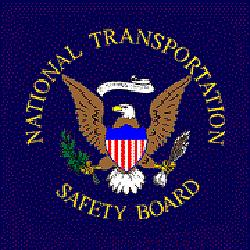Safety Board Lists Its Priorities For Aviation Safety
Improvements
 The National Transportation Safety
Board said Tuesday that the government should be doing more to
prevent accidents and enhance safety for the traveling public. The
Board updated its list of Most Wanted Safety Improvements, noting
instances where federal agencies had given unacceptable responses
to NTSB recommendations or were moving too slowly to implement
recommended safety measures.
The National Transportation Safety
Board said Tuesday that the government should be doing more to
prevent accidents and enhance safety for the traveling public. The
Board updated its list of Most Wanted Safety Improvements, noting
instances where federal agencies had given unacceptable responses
to NTSB recommendations or were moving too slowly to implement
recommended safety measures.
Two items were removed from the list, one because action on it
is almost completed, and the other because the Federal Railroad
Administration (FRA) refused to adopt the recommended safety
enhancement.
Established in 1990, the Most Wanted list is a way for the NTSB
to focus attention on needed safety improvements in all modes of
transportation. The list highlights recommendations that the Board
believes would significantly reduce deaths and injuries.
"Our recommendations are derived from the hard lessons we have
learned over the years investigating many tragic accidents," said
NTSB Chairman Ellen Engleman Conners. "Quite simply, implementing
these measures will save lives."
In aviation, the Board reviewed the status of recommendations in
six issue areas:
Runway Incursions
 The Board's recommendation calls for
a system that ensures safe movement of airplanes on the ground and
provides warnings of probable collisions/incursions directly to
flight crews in the cockpit. To illustrate the potential dangers of
a runway incursion, the Board viewed a simulation, prepared by NTSB
staff, of a near-collision at Los Angeles last August involving two
large airliners, a B-747 and a B-737. This incident was not
reported by air traffic control officials as an operational error.
"The fact that such incidents are not being reported casts doubt on
the FAA's claims that the runway incursion rate is declining,"
Chairman Engleman Conners said. "The FAA needs to review its
reporting process." Status: The Board changed the classification of
the Federal Aviation Administration's (FAA) response to this
recommendation from "Open-Acceptable Response" to
"Open-Unacceptable Response."
The Board's recommendation calls for
a system that ensures safe movement of airplanes on the ground and
provides warnings of probable collisions/incursions directly to
flight crews in the cockpit. To illustrate the potential dangers of
a runway incursion, the Board viewed a simulation, prepared by NTSB
staff, of a near-collision at Los Angeles last August involving two
large airliners, a B-747 and a B-737. This incident was not
reported by air traffic control officials as an operational error.
"The fact that such incidents are not being reported casts doubt on
the FAA's claims that the runway incursion rate is declining,"
Chairman Engleman Conners said. "The FAA needs to review its
reporting process." Status: The Board changed the classification of
the Federal Aviation Administration's (FAA) response to this
recommendation from "Open-Acceptable Response" to
"Open-Unacceptable Response."
Fuel/Air Vapors in Fuel Tanks
Recommendations call for interim measures to reduce flammable
fuel/air vapors in fuel tanks and, longer term, airplane design
changes to eliminate the generation of such vapors. Status: Due to
the lack of FAA initiatives on interim measures, the Board decided
to reclassify the short-term recommendation from "Open-Acceptable
Response" to "Open-Unacceptable Response." On the longer-term
recommendation, the Board found the FAA's response acceptable. The
Board is anticipating that the FAA will begin the regulatory
process to require a flammability reduction system in the near
future. Overall, the Board noted that implementation was
progressing too slowly.
Aircraft Icing
 To reduce the dangers of flying in
icing conditions, NTSB recommendations call for expedited research
and upgraded airplane design and certification standards. Status:
Noting that the oldest icing recommendations on the list date back
eight years, the Board changed the classification of this issue
from "Open-Acceptable Response," but progressing slowly, to
"Open-Unacceptable Response" based on the FAA's lack of progress in
this area.
To reduce the dangers of flying in
icing conditions, NTSB recommendations call for expedited research
and upgraded airplane design and certification standards. Status:
Noting that the oldest icing recommendations on the list date back
eight years, the Board changed the classification of this issue
from "Open-Acceptable Response," but progressing slowly, to
"Open-Unacceptable Response" based on the FAA's lack of progress in
this area.
Audio, Data and Video Recorders
Recommendations specify at least two hours of audio recording
capability, back-up power sources, and a requirement for video
recorders in the cockpit to give investigators more information to
solve complex accidents. Status: The Board noted some progress by
the FAA on a few recommendations in this issue area but retained
the overall classification of "Open-Unacceptable Response."
Child Restraints
Recommendation asks for a requirement that infants and toddlers
under age two be safely restrained on takeoff, landing and in
turbulence. Status: Unacceptable response from FAA.
 ANN's Daily Aero-Linx (04.15.24)
ANN's Daily Aero-Linx (04.15.24) Classic Aero-TV: 'No Other Options' -- The Israeli Air Force's Danny Shapira
Classic Aero-TV: 'No Other Options' -- The Israeli Air Force's Danny Shapira Aero-News: Quote of the Day (04.15.24)
Aero-News: Quote of the Day (04.15.24) Airborne 04.16.24: RV Update, Affordable Flying Expo, Diamond Lil
Airborne 04.16.24: RV Update, Affordable Flying Expo, Diamond Lil ANN's Daily Aero-Term (04.16.24): Chart Supplement US
ANN's Daily Aero-Term (04.16.24): Chart Supplement US





